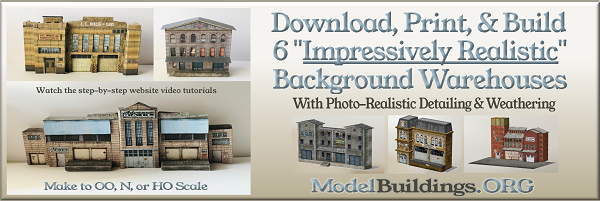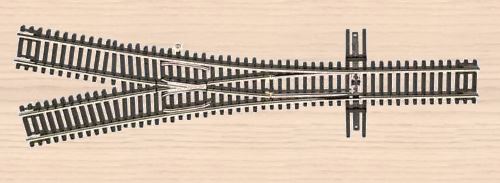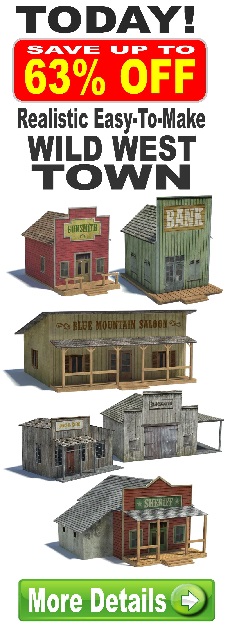Everything on model trains, model railroads, model railways, locomotives, model train layouts, scenery, wiring, DCC and more. Enjoy the world's best hobby... model railroading!
Why Have Wye Reversing Tracks?
When most steam and some diesel locomotives reach the end of their run, they need to be turned around to head back in the other direction. If that station doesn’t have a turntable or a reversing loop track, they need a wye reversing track, commonly just called a wye.
Because of its size, a wye is usually located near the end of the yard, or track. Looking down on a wye is often like looking down on an equilateral triangle, with three equal sides, with one end connected to the yard track. At each corner is located a turnout or switch, often a wye switch, with the diverging tracks of equal angle, and beyond each turnout a short track to hold the locomotive and still clear the points of the turnout.
Operating a Wye
We can call the corner turnouts #1, #2, and #3, or 1, 3, 2, it makes no difference as the wye works just as well in either direction. For this example we will go #1, #2, #3. Turnouts #1 & #2 are aligned together and the locomotive proceeds forward through both turnouts and stops on the short track beyond #2. Now turnouts #2 & #3 are aligned and the locomotive proceeds backwards to the short track beyond #3. Finally turnouts #3 & #1 are aligned and the locomotive proceeds forward to the original track, except in the opposite direction.
On a model railroad each turnout must be powered, and isolated from the others with gaps. A wye is just a complicated reversing loop, but in a more compact space.
Add your comment.
8 Responses to Why Have Wye Reversing Tracks?
Leave a Reply

















Yes it was to turn a train around to go in the opposite direction and pull a train back instead of pushing. Many mining RR and Logging RR used them because of steep grades and it was cheaper to use a wye rather than a turn table. Geography also made a turn table expensive and in addition when the logs and ore was exhausted the RR picked up there tracks and moved to a new location.
either I am thick or i do not understand your explanation of how this works.
regards les
I am with Les, I do not understand either. are there 3 WYES or two engines
A Y configuration has three sets of turnouts with track connected in a triangle shape the engine runs to the right on the first Y to the second Y then reverses to the third Y then forward to the first Y again on the Virginia and Truckee line when it went to Minden they ran the entire train through the Y to turn it around, with those trains they only consisted of three or four passenger cars.
The Wyes are used in real operations . Among them would be a train that would be doing a milk run delivering and picking up along a section. But they need to get back to the yard and running the train backwards works but is difficult at you need eyes from the rear of the train. So they would work deliveries to and return to points that would have a wye to turn the train or at least the engine so they can ride facing forward. Here at home there is a Wye that is near the yard and it normally connects to another railroad. Up the tracks there will be another wye maybe at another rail crossing or another switch yard. Another way to not have to use a wye track would be to have a pair of engines facing the opposite directions and they would pull into a siding,uncouple and go back to the other end of the train on the main track and reconnect to the rear of the train. Your other engine is now the lead engine.
Newman
On the real railroads such as Amtrak, Their route may take them down along the Mississippi River but the tracks on that side of the river might be flooded. So they then will take the tracks across the river up where they met it and cross there on to a competitor tackage down the other side where it is not flooded. Like with Amtrak they have to pick up a crew that knows their tracks until they are back on their own route again. But in the case of arriving at the normal crossing of the river the only way to head east was to turn west and cross the river where there was a wye on the other side.(there was no track to turn left and head on your regular route. They would pull the whole train through the wye and back up through the other section of it then return back across the river on it’s regular route. On another case the UP Coal train comes across the Wabash River. Where he is going there is no right turn after crossing. So he will travel through town to the wye that connects to the competitor’s route, travel through that sharp wye change crews (he is on different railroad now) and then follow it as it circles town and reconnects south of town. There are many ways you can use the wye. track and turn a round.
Newman
The explanation is a little confusing. The pic shows just one “Y” “turnout” in practice there maybe one Y and two simple turnouts. They are connected to form a triangular shape, explanation as from Kevin. If you Google “Reversing a train with a Y” one result is
from Wikipedia http://en.wikipedia.org/wiki/Wye_%28rail%29 shows a basic diagram.
This is easy to understand.
I have also seen one in Italian which called itself a Stella di Inversione which has the same function in a little less space but is a five-pointed star.
Bernard
We had the same type of thing here in Australia only it was called a triangle. Very easy to turn an engine when there was no turntable.